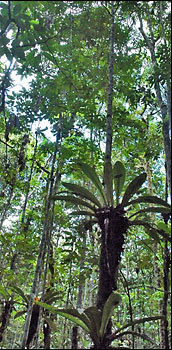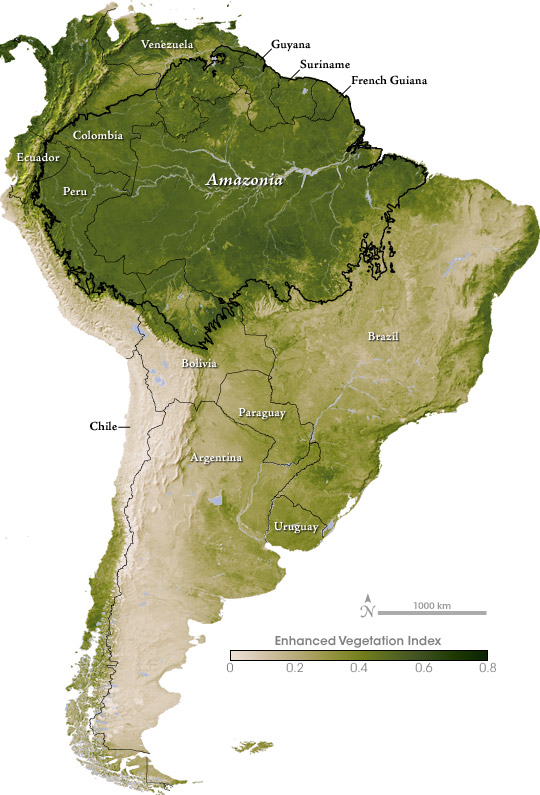

When Alfredo Huete saw Scott Saleska’s poster presentation at a meeting of the American Geophysical Union in 2002, he felt like he had been vindicated. Several years before, Huete had been sponsored by NASA to develop techniques for mapping global vegetation using data from a new sensor planned for two of the space agency’s upcoming Earth-observing satellite missions. For several years after Terra, the first satellite, launched in 1999, the University of Arizona remote-sensing ecologist had been worrying over the data processing and mapping technique he and his team had proposed. For nearly two decades, scientists had been mapping global vegetation patterns using a vegetation scale, or index, based on data from a series of satellite sensors operated by the National Oceanic and Atmospheric Administration. The NASA sensors built on and even surpassed the capabilities of the previous sensors, but still, Huete had to deal with a new kind of satellite sensor, a new method for producing the vegetation maps—and the awareness that he was making a product that would go out into a global research community with NASA’s name on it. “I felt a lot of pressure,” Huete says. |

Layer upon layer of vegetation stretches from the forest floor to the top of the Amazon Rainforest canopy. Surprisingly, parts of this lush forest go several months each year with little or no rain. The forest actually greens up in the dry season, due to sunny days and water sucked up from deep in the soil by long roots. (Photograph copyright Naadir Jeewa.) |
||
 | |||
As they were developing and testing their technique, Huete and his team frequently checked that the maps matched real-world seasonal changes in vegetation in different ecosystems, from African savannas to eastern North American forests. Although their maps captured the expected seasonal changes in most areas, one area bothered Huete: the Amazon. As data from Terra began accumulating, he noticed something peculiar: the Amazon rainforest looked greener to the satellite in the forest’s dry season than it did during the rainy season. Huete knew that parts of the forest go several months with little or no rain. How could the forest be thriving during those times of seasonal drought? |
Amazonia covers most of tropical South America east of the Andes Mountains. Primarily rainforest, the region includes some of the densest vegetation on Earth. This map shows average August plant density and greenness in South America. Beige areas indicate sparse vegetation, while dark green areas represent dense vegetation. NASA satellite vegetation maps revealed that the Amazon is greener in the dry season than the rainy season, defying conventional wisdom. (Map by Robert Simmon, based on data from the University of Arizona Terrestrial Biophysics and Remote Sensing Lab.) | ||

Before the 2002 conference Huete had spent several years repeatedly tinkering with the data and the mapping technique. “When you see something you are not expecting, you have to ask yourself, ‘What are all the possibilities for a remote-sensing product going wrong?’” Among the possibilities are things in the atmosphere that keep the satellite from having a clear view of the surface. “We checked for aerosols [particles in the air, such as smoke from biomass burning] and clouds, which can potentially reduce the vegetation signal obtained by satellites. Someone suggested that maybe there was flooding on the forest floor during the wet season, so we looked at that. We looked how the vegetation maps changed if the light [hitting a particular patch of vegetation] was direct or diffuse. We just kept re-doing and re-doing the data products,” he says. Each time they made a change, they wondered if the dry-season green-up would disappear. But with each refinement, it stayed. His confidence grew, but Huete still wasn’t sure. Was this for real? Or was it just a sign he was still doing something wrong? |
Satellite vegetation maps should match well-known seasonal changes in ecosystems. Satellite measurements collected over ground-based research sites in Massachusetts (top) and Brazil (lower) are shown here as graphs and as a filmstrip of pictures. At Harvard Forest, the seasonal (48-day) satellite observations matched the scientists’ expectations: the numbers were highest and the pictures were greenest in summer, lowest and brownest in winter. But over the Amazon, numbers on the graph and the greenness in the pictures went up during the dry season—when scientists expected the forest to be under stress. (Map by Robert Simmon and Jesse Allen, based on data from the Oak Ridge National Laborary DAAC.) | ||
 | |||
When satellite maps of Amazon vegetation showed unexpected seasonal patterns, Huete and his colleagues began to check out ways that remote-sensing observation can go wrong. This NASA satellite image acquired October 7, 2005, shows thin clouds and smoke partially obscuring the land surface. Huete’s team checked their data for errors caused by clouds, smoke, and changes in lighting to ensure their measurements were accurate. (Image by Robert Simmon, based on data from the Moderate Resolution Imaging Spectroradiometer.) | |||